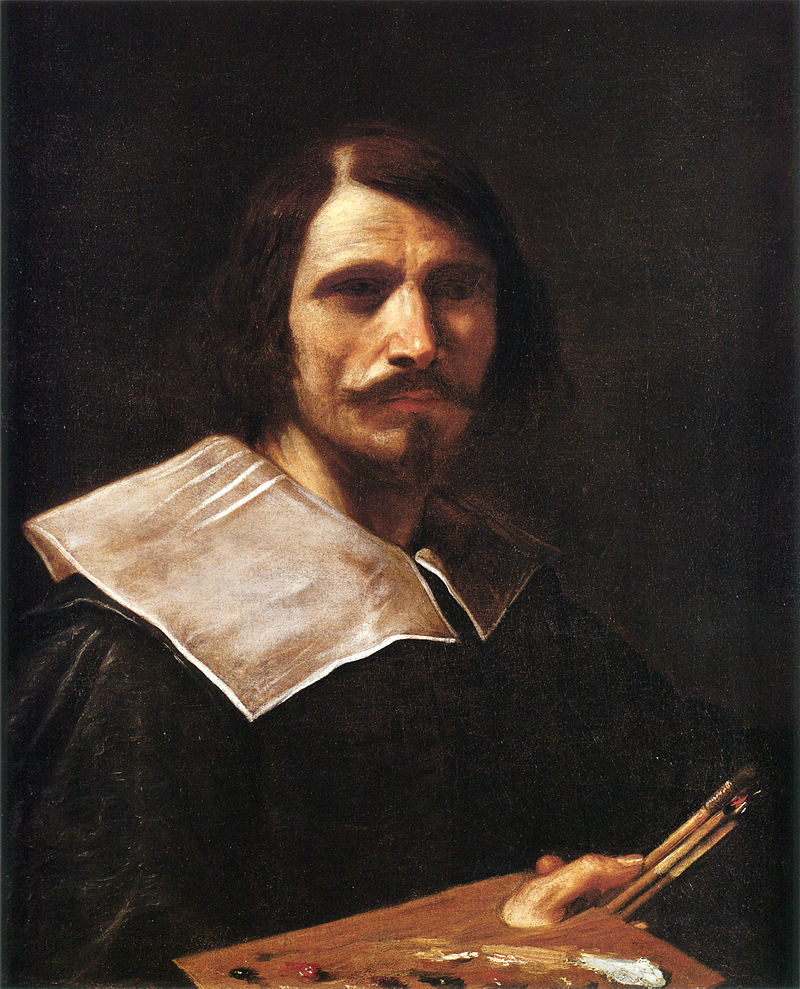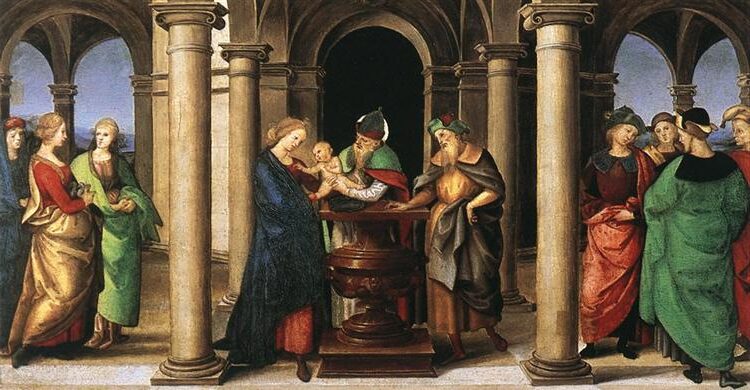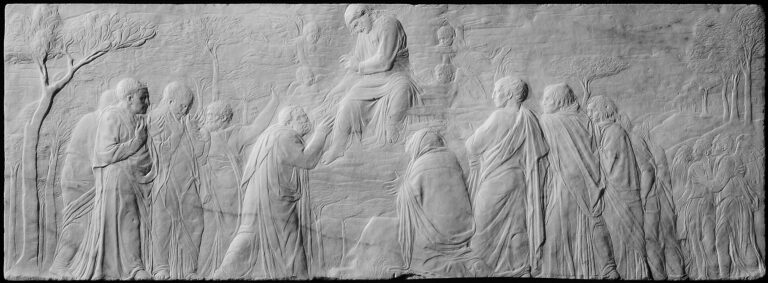Guercino Painter: Masterful Baroque Artist of 17th Century Italy
Born: February 8, 1591, Cento, Duchy of Ferrara
Death: December 22, 1666, Bologna, Papal States
Mouvement artistique : Baroque
Nationalité : Italien
Enseignant : Autodidacte
Guercino Painter: Masterful Baroque Artist of 17th Century Italy
Life and Career of Guercino
Giovanni Francesco Barbieri, better known as Guercino, lived a remarkable life as one of the most significant Italian Baroque painters. His artistic journey took him from his humble beginnings in Cento to prestigious commissions in Rome and Bologna.
Les débuts de la vie
Guercino was born on February 8, 1591, in Cento, a small town near Bologna, Italy. His nickname “Guercino” (meaning “the squinter”) referred to his pronounced squint. Despite having no formal training, he showed artistic talent from a young age.

Saint Matthew and the Angel (1622) by Guercino
As a young artist, Guercino taught himself by studying the works of the Carracci family and other Bolognese painters. His natural ability and keen observation skills helped him develop his distinctive style.
By his early twenties, Guercino had established a workshop in his hometown of Cento. He began as a mural painter, creating works for local churches and patrons.
Développement en tant qu'artiste
Throughout his career, Guercino’s style underwent significant changes. His early works showed strong influences from Caravaggio, with dramatic lighting and naturalistic depictions of subjects.
In 1617, he visited Venice, where he was exposed to the rich colors and compositional techniques of Venetian painters. This experience broadened his artistic vision and influenced his use of color.
By 1621, Guercino’s reputation had grown substantially. His ability to blend naturalism with emotional expressiveness made him one of the most sought-after painters of his time.
His drawing skills were exceptional. Guercino produced numerous sketches and preparatory drawings, which are now considered valuable works of art in their own right.
Major Commissions and Works
Pope Gregory XV summoned Guercino to Rome in 1621, marking a turning point in his career. In Rome, he received prestigious commissions and created some of his most celebrated works.

Christ and the Woman of Samaria (c. 1619–1620) by Guercino
One of his masterpieces from this period is “The Burial of Saint Petronilla,” painted for St. Peter’s Basilica. The work showcases his mature style with its balanced composition and emotional depth.
When working in Rome, Guercino felt pressure to adopt a more classicizing style that was popular at the time. This led to a shift in his approach, making his paintings more measured and restrained.
After Gregory XV’s death in 1623, Guercino returned to Cento. He continued to receive important commissions from throughout Italy during this period.
Les dernières années et la mort
In 1642, Guercino relocated to Bologna, where he remained for the rest of his life. Following the death of Guido Reni, he became the leading painter in the city.
His later style became softer and more refined. The dramatic contrasts of his earlier works gave way to more delicate color harmonies and graceful compositions.
Despite changing artistic tastes, Guercino maintained a productive workshop and continued to receive commissions until his final years. His dedication to his craft never wavered.
Guercino died on December 22, 1666, in Bologna at the age of 75. He left behind a rich artistic legacy that includes paintings, frescoes, and drawings that continue to be admired for their technical brilliance and emotional power.
Style et influence artistiques

The Woman Taken in Adultery (1621) by Guercino
Guercino, born Giovanni Francesco Barbieri, developed a distinctive artistic approach that evolved significantly throughout his career. His work is characterized by dramatic tonal contrasts, emotional expressiveness, and masterful draftsmanship that set him apart from his contemporaries.
Baroque Characteristics
Guercino embodied key Baroque elements in his paintings, particularly through his use of strong light-dark contrasts. His early works featured energetic compositions with dynamic movement and emotional intensity that captured viewers’ attention.
Unlike some of his contemporaries, Guercino balanced dramatic elements with a sense of moral grace and calm freedom. This unique combination gave his paintings both visual impact and spiritual depth.
During his time in Rome, Guercino shifted toward a more classicizing style due to artistic pressures. This demonstrates his adaptability and awareness of artistic trends while maintaining his personal vision.
His paintings often feature dramatic scenes with theatrical lighting that create powerful visual experiences typical of Baroque sensibilities.
Techniques et supports
Guercino excelled across various artistic mediums, but his drawings and watercolors were particularly celebrated. His sketches reveal exceptional skill in capturing form and movement with minimal lines.

Moonlit Landscape (c. 1616) by Guercino
He specialized in tonal contrasts through careful shading and blurring techniques. This approach created a sense of depth and atmosphere in his work that many of his contemporaries could not achieve.
As a fresco painter, Guercino masterfully exploited illusionistic ceiling techniques. These works made a profound impact on 17th-century decorative painting and influenced generations of artists.
His technical approach evolved from more dramatic shadowing in his early career toward lighter palettes and more refined brushwork in his mature period.
Influencers and Contemporaries
Ludovico Carracci and his cousins Annibale and Agostino significantly shaped Guercino’s artistic development. Their dramatic use of light and shadow can be seen throughout his work.
The Carracci family pioneered a return to naturalism in painting, and Guercino embraced this philosophy while adding his personal dramatic flair.
He belonged to the Bolognese school of painting, which emphasized classical training and drawing from life. This foundation gave his work structural integrity even at its most expressive moments.
While influenced by Caravaggio’s revolutionary approach to light, Guercino developed a softer, more accessible style that avoided harsh realism but maintained emotional impact.
Contribution to Art History
Guercino’s work bridges several important artistic developments in the 17th century. His evolving style shows the transition from early Baroque drama to more measured classical approaches.
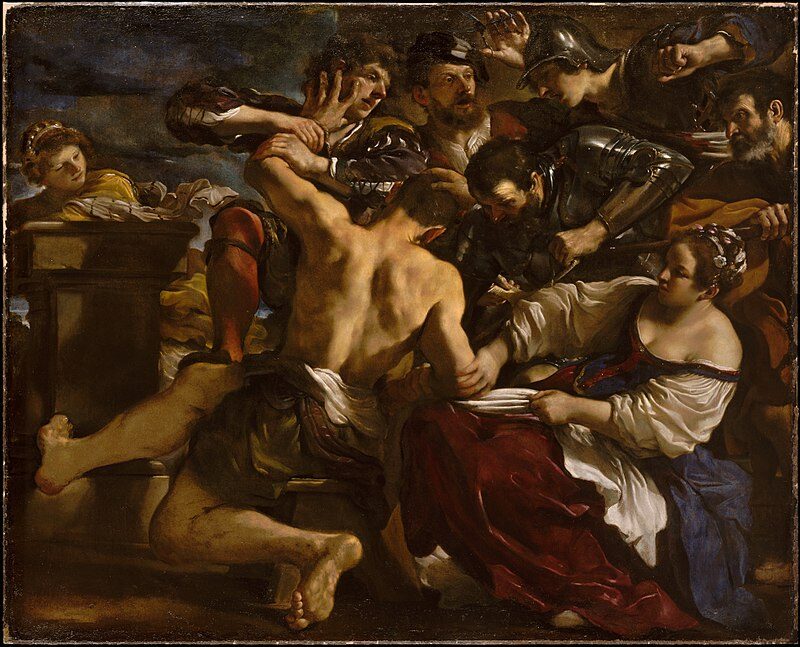
Samson Seized by the Philistines (1619) by Guercino
His paintings demonstrate that technical virtuosity and emotional authenticity can coexist. This balance made his work highly prized both in his lifetime and by later collectors.
Art historians particularly value Guercino’s ability to adapt without compromising artistic integrity. His willingness to evolve while maintaining core strengths represents an important model for artistic development.
His frescoes and ceiling paintings expanded the visual language of Baroque art. These innovations influenced decorative painting throughout Italy and beyond.
Guercino’s legacy lives on in his voluminous body of work, which continues to be studied for its technical excellence and emotional resonance.
Héritage et reconnaissance
Guercino’s artistic legacy spans centuries, marked by periods of both acclaim and relative obscurity. His technical brilliance and emotional depth in paintings have secured his place among the important figures of Art baroque, though his recognition has fluctuated over time.
Posthumous Fame
After his death in 1666, Guercino’s reputation remained strong throughout the 17th and 18th centuries. His work was highly valued by collectors and fellow artists who appreciated his mastery of composition and color.
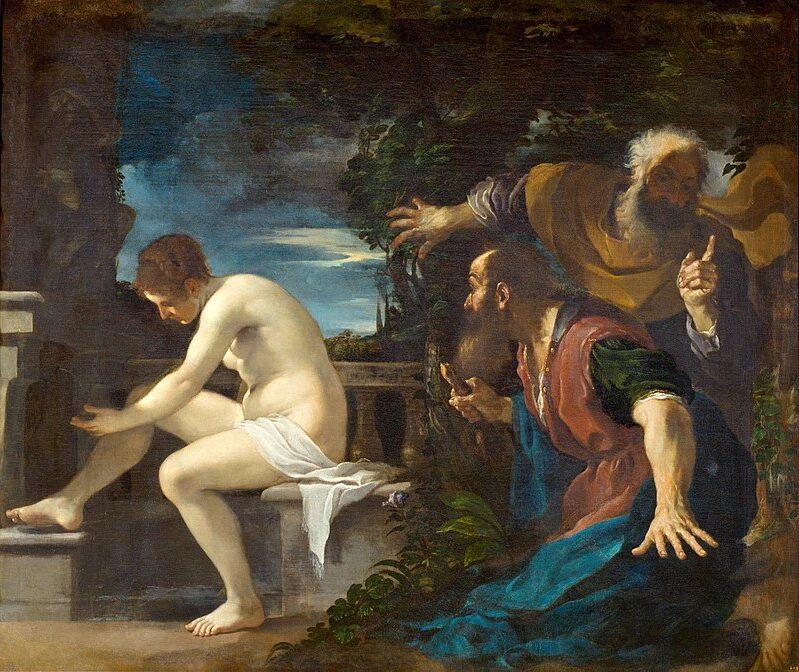
Susanna and the Elders (1617) by Guercino
However, his fame diminished during the 19th century when Baroque art fell out of favor. Critics and art historians often overlooked his contributions while focusing on other periods and styles.
The 20th century brought renewed interest in Guercino’s work. Art historians began to reassess his importance, recognizing his unique position between the classical and naturalistic approaches of the Baroque period.
Today, Guercino is acknowledged as one of the most significant Italian painters of his time, with scholars particularly noting his exceptional draftsmanship and emotional expressiveness.
Expositions notables
Major exhibitions have helped reestablish Guercino’s importance in art history. The landmark “Guercino: Master Painter of the Baroque” exhibition at the National Gallery in Washington DC (1992) introduced his genius to American audiences.
In 2011, Bologna hosted “Guercino: The Triumph of Baroque,” showcasing over 100 works to commemorate the 350th anniversary of his return to Bologna.
The 2018 exhibition “Guercino: Virtuoso Draftsman” at the Morgan Library & Museum in New York highlighted his drawing skills with rarely seen works on paper.
His hometown of Cento regularly celebrates his legacy through exhibitions at the Pinacoteca Civica Il Guercino, which houses a significant collection of his works.
These exhibitions have helped modern audiences appreciate his technical brilliance and emotional depth that made him highly esteemed during his lifetime.
Œuvres dans les grandes collections
Guercino’s paintings grace many of the world’s finest museums. The Louvre in Paris holds several masterpieces, including “The Resurrection” and “Saint Jerome in the Wilderness.”
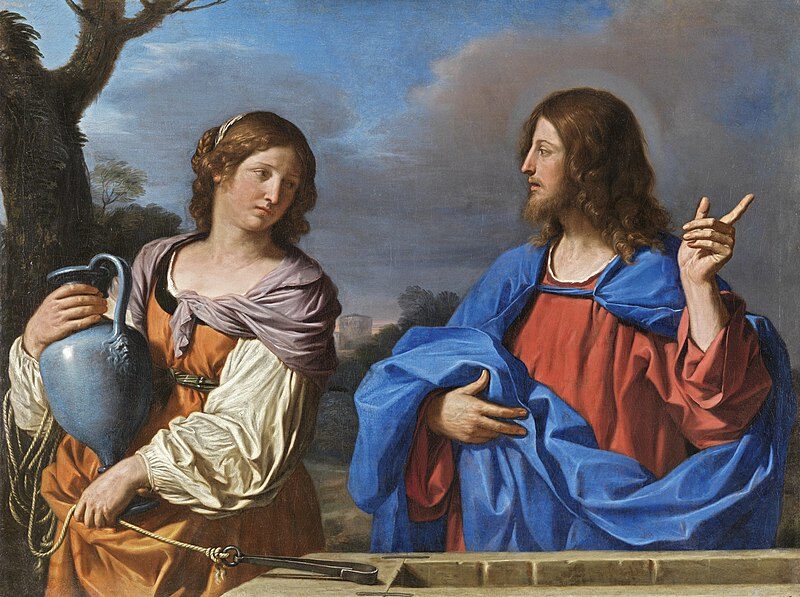
Christ and the Woman of Samaria II (c. 1640–1641)
The Vatican Museums display his “The Burial of Saint Petronilla,” considered one of his greatest achievements.
In Britain, the Royal Collection contains numerous Guercino drawings collected by King George III, showing the artist’s popularity among royal collectors.
The Art Institute of Chicago houses “The Return of the Prodigal Son,” demonstrating his skill with biblical narratives.
His works can also be found in the Prado (Madrid), Uffizi Gallery (Florence), and Metropolitan Museum of Art (New York), reflecting his international significance and appeal to major collectors throughout history.
Influence sur l'art moderne
Guercino’s influence extends beyond his era into contemporary art practice. His dramatic lighting techniques and emotional expressiveness influenced later generations of artists, particularly those interested in theatrical compositions.

Return of the Prodigal Son (1619) by Guercino
Modern painters studying Baroque techniques often look to Guercino’s handling of light and shadow as exemplary of the period’s visual drama.
His rapid, confident drawing style continues to be studied by art students seeking to master figure drawing and compositional techniques.
Contemporary exhibitions frequently pair his work with modern artists, highlighting continuing connections in approaches to narrative and emotional content.
While not as widely recognized as contemporaries like Caravaggio, Guercino’s technical innovations and psychological depth in portraiture have secured his legacy as an artist worthy of continued study and admiration.
Questions fréquemment posées
Guercino remains one of the most fascinating Baroque painters with his distinctive style and significant artistic contributions. His work continues to intrigue art historians and enthusiasts alike, prompting many questions about his techniques and legacy.
What are the distinctive characteristics of Guercino’s painting style?
Guercino’s painting style features dramatic chiaroscuro effects with strong contrasts between light and dark. This technique creates depth and emotional intensity in his compositions.
His early works show more dramatic, almost theatrical lighting influenced by Caravaggio. The brushwork is often loose and energetic, giving his paintings a sense of movement and life.
Guercino also employed rich, vibrant colors that became more subdued in his later career. His figures are characterized by naturalistic poses and expressive faces showing genuine human emotion.
Which museums around the world house notable works by Guercino?
The Pinacoteca Nazionale in Bologna holds several significant Guercino paintings, including “St. William of Aquitaine” and “The Return of the Prodigal Son.”
The Louvre in Paris displays his masterpiece “Et in Arcadia ego” along with other important works. The Vatican Museums feature his religious paintings, particularly in the Pinacoteca Vaticana.
The National Gallery in London houses “The Angel Appears to Hagar” and other notable works. The Metropolitan Museum of Art in New York and the Prado in Madrid also contain significant examples of Guercino’s artistry.
How has Guercino influenced the Baroque art movement?
Guercino played a crucial role in developing the Baroque style in the Emilian region of Italy. His dynamic compositions and dramatic lighting became hallmarks of the movement.
His masterful integration of figures within architectural spaces influenced ceiling decorations throughout Europe. Many later Baroque painters studied his techniques for creating emotional and spiritual intensity.
Guercino’s ability to blend classical restraint with emotional drama created a balanced approach that many artists sought to emulate. His workshop trained numerous followers who spread his influence throughout Italy and beyond.
Can you describe the significance of Guercino’s ‘Et in Arcadia ego’ painting?
“Et in Arcadia ego” represents one of Guercino’s most profound philosophical statements. The painting depicts shepherds discovering a skull with the titular inscription, conveying the message that death exists even in paradise.
The work explores the concept of memento mori (remember death) within a pastoral setting. This juxtaposition creates a powerful meditation on mortality and the transience of earthly pleasures.
The painting’s composition balances classical elements with emotional expressiveness. Its influence extended beyond art to literature and philosophy, helping to establish this theme as a central concept in Baroque culture.
What are some of the major themes depicted in Guercino’s artwork?
Religious narratives form the backbone of Guercino’s artistic output. He painted numerous scenes from both the Old and New Testament with particular emphasis on moments of divine revelation or spiritual transformation.
Mythological subjects allowed Guercino to explore classical themes while showcasing his skill in depicting the human form. These works often contain moral or allegorical meanings beneath their surface narratives.
Portraiture also features prominently in his repertoire, revealing his ability to capture both physical likeness and inner character. His portraits humanize their subjects while maintaining a sense of dignity and presence.
How did Guercino’s technique evolve throughout his career?
Guercino’s early period shows strong influence from Caravaggio. His dramatic style has dramatic lighting and energetic compositions. This style dominated his work until around 1630.
Following the death of Guido Reni in 1642, Guercino modified his approach significantly. His later works feature more classical composition, softer lighting, and a more refined color palette reflecting broader artistic trends.
Despite these stylistic changes, Guercino maintained a consistent demand for his paintings throughout his career. His ability to adapt while maintaining his artistic integrity demonstrates his versatility and technical mastery as a painter.


